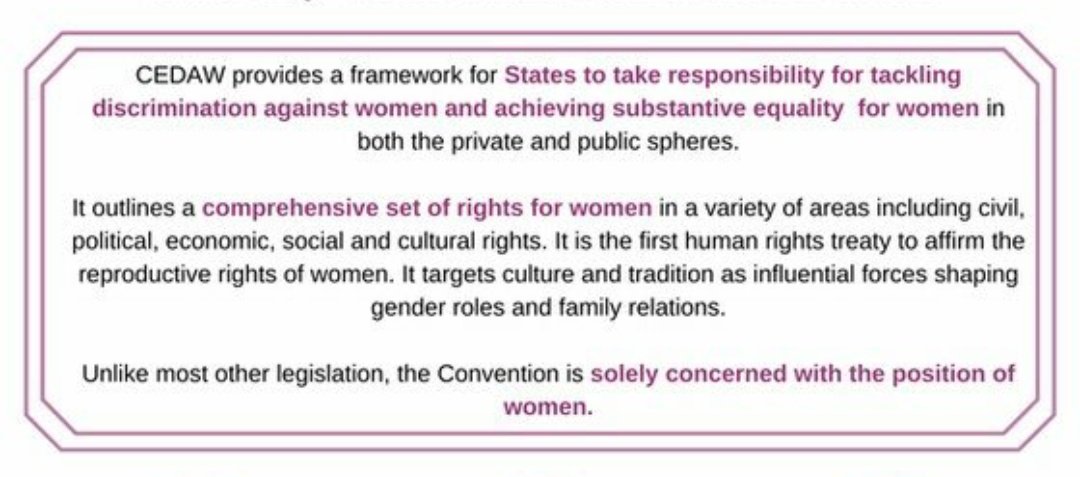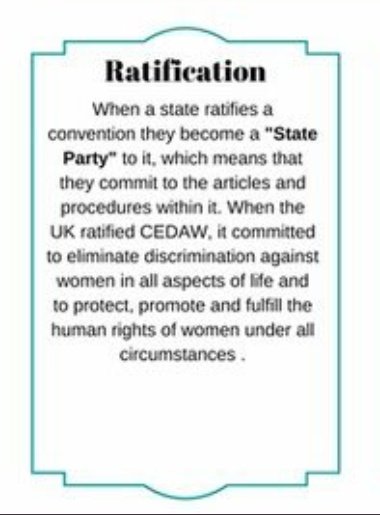FAQ time! https://abs.twimg.com/emoji/v2/... draggable="false" alt="💡" title="Elektrische Glühbirne" aria-label="Emoji: Elektrische Glühbirne">
https://abs.twimg.com/emoji/v2/... draggable="false" alt="💡" title="Elektrische Glühbirne" aria-label="Emoji: Elektrische Glühbirne">
 https://abs.twimg.com/emoji/v2/... draggable="false" alt="❓" title="Rotes Fragezeichen-Symbol" aria-label="Emoji: Rotes Fragezeichen-Symbol">So, what is CEDAW?
https://abs.twimg.com/emoji/v2/... draggable="false" alt="❓" title="Rotes Fragezeichen-Symbol" aria-label="Emoji: Rotes Fragezeichen-Symbol">So, what is CEDAW? https://abs.twimg.com/emoji/v2/... draggable="false" alt="🤔" title="Denkendes Gesicht" aria-label="Emoji: Denkendes Gesicht">
https://abs.twimg.com/emoji/v2/... draggable="false" alt="🤔" title="Denkendes Gesicht" aria-label="Emoji: Denkendes Gesicht">
CEDAW stands for the Convention on the Elimination of all forms of Discrimination Against Women
 https://abs.twimg.com/emoji/v2/... draggable="false" alt="✅" title="Fettes weißes Häkchen" aria-label="Emoji: Fettes weißes Häkchen">Adopted by the UN in 1979
https://abs.twimg.com/emoji/v2/... draggable="false" alt="✅" title="Fettes weißes Häkchen" aria-label="Emoji: Fettes weißes Häkchen">Adopted by the UN in 1979
 https://abs.twimg.com/emoji/v2/... draggable="false" alt="✒" title="Schreibfeder" aria-label="Emoji: Schreibfeder">Signed by the UK in 1981
https://abs.twimg.com/emoji/v2/... draggable="false" alt="✒" title="Schreibfeder" aria-label="Emoji: Schreibfeder">Signed by the UK in 1981
 https://abs.twimg.com/emoji/v2/... draggable="false" alt="🔒" title="Schloss" aria-label="Emoji: Schloss">Ratified by the UK in 1986
https://abs.twimg.com/emoji/v2/... draggable="false" alt="🔒" title="Schloss" aria-label="Emoji: Schloss">Ratified by the UK in 1986
Also known as the & #39;International Bill of Rights for Women& #39; https://abs.twimg.com/emoji/v2/... draggable="false" alt="⚖" title="Waage" aria-label="Emoji: Waage">
https://abs.twimg.com/emoji/v2/... draggable="false" alt="⚖" title="Waage" aria-label="Emoji: Waage">
CEDAW stands for the Convention on the Elimination of all forms of Discrimination Against Women
Also known as the & #39;International Bill of Rights for Women& #39;
What does CEDAW do?
 https://abs.twimg.com/emoji/v2/... draggable="false" alt="📝" title="Memo" aria-label="Emoji: Memo">CEDAW provides a framework for States to elimination discrimination against women and achieve #SubstanticeTransformativeEquality
https://abs.twimg.com/emoji/v2/... draggable="false" alt="📝" title="Memo" aria-label="Emoji: Memo">CEDAW provides a framework for States to elimination discrimination against women and achieve #SubstanticeTransformativeEquality
It sets out a comprehensive set of rights for women & girls, including political, social, economic & cultural rights https://abs.twimg.com/emoji/v2/... draggable="false" alt="⚖" title="Waage" aria-label="Emoji: Waage">
https://abs.twimg.com/emoji/v2/... draggable="false" alt="⚖" title="Waage" aria-label="Emoji: Waage">
It sets out a comprehensive set of rights for women & girls, including political, social, economic & cultural rights
What does it mean to & #39;ratify& #39; a treaty?
 https://abs.twimg.com/emoji/v2/... draggable="false" alt="✒" title="Schreibfeder" aria-label="Emoji: Schreibfeder">When the UK ratified CEDAW in 1986, it officially committed itself to carrying out the principles and measures of CEDAW. This means the UK is legal bound to its commitment to eliminate discrimination and pursue #GenderEquality for all
https://abs.twimg.com/emoji/v2/... draggable="false" alt="✒" title="Schreibfeder" aria-label="Emoji: Schreibfeder">When the UK ratified CEDAW in 1986, it officially committed itself to carrying out the principles and measures of CEDAW. This means the UK is legal bound to its commitment to eliminate discrimination and pursue #GenderEquality for all  https://abs.twimg.com/emoji/v2/... draggable="false" alt="📝" title="Memo" aria-label="Emoji: Memo">
https://abs.twimg.com/emoji/v2/... draggable="false" alt="📝" title="Memo" aria-label="Emoji: Memo">
What does CEDAW cover?
CEDAW has a wide reach - securing rights for ALL women & girls, including:
 https://abs.twimg.com/emoji/v2/... draggable="false" alt="🗳" title="Wahlurne mit Stimmzettel" aria-label="Emoji: Wahlurne mit Stimmzettel">Political rights & participation
https://abs.twimg.com/emoji/v2/... draggable="false" alt="🗳" title="Wahlurne mit Stimmzettel" aria-label="Emoji: Wahlurne mit Stimmzettel">Political rights & participation
 https://abs.twimg.com/emoji/v2/... draggable="false" alt="🌍" title="Europa-Afrika auf dem Globus" aria-label="Emoji: Europa-Afrika auf dem Globus">Nationality rights
https://abs.twimg.com/emoji/v2/... draggable="false" alt="🌍" title="Europa-Afrika auf dem Globus" aria-label="Emoji: Europa-Afrika auf dem Globus">Nationality rights
 https://abs.twimg.com/emoji/v2/... draggable="false" alt="👩🎓" title="Woman student" aria-label="Emoji: Woman student">Education
https://abs.twimg.com/emoji/v2/... draggable="false" alt="👩🎓" title="Woman student" aria-label="Emoji: Woman student">Education
 https://abs.twimg.com/emoji/v2/... draggable="false" alt="👩🏽🏭" title="Woman factory worker (mittlerer Hautton)" aria-label="Emoji: Woman factory worker (mittlerer Hautton)">Employment
https://abs.twimg.com/emoji/v2/... draggable="false" alt="👩🏽🏭" title="Woman factory worker (mittlerer Hautton)" aria-label="Emoji: Woman factory worker (mittlerer Hautton)">Employment
 https://abs.twimg.com/emoji/v2/... draggable="false" alt="👩🏻⚕️" title="Woman health worker (heller Hautton)" aria-label="Emoji: Woman health worker (heller Hautton)">Health
https://abs.twimg.com/emoji/v2/... draggable="false" alt="👩🏻⚕️" title="Woman health worker (heller Hautton)" aria-label="Emoji: Woman health worker (heller Hautton)">Health
 https://abs.twimg.com/emoji/v2/... draggable="false" alt="💰" title="Geldsack" aria-label="Emoji: Geldsack">Economic & social benefits
https://abs.twimg.com/emoji/v2/... draggable="false" alt="💰" title="Geldsack" aria-label="Emoji: Geldsack">Economic & social benefits
 https://abs.twimg.com/emoji/v2/... draggable="false" alt="⚖" title="Waage" aria-label="Emoji: Waage">Equality before the law
https://abs.twimg.com/emoji/v2/... draggable="false" alt="⚖" title="Waage" aria-label="Emoji: Waage">Equality before the law
 https://abs.twimg.com/emoji/v2/... draggable="false" alt="👨👩👧👦" title="Normale Familie (Mann, Frau, Mädchen, Junge)" aria-label="Emoji: Normale Familie (Mann, Frau, Mädchen, Junge)">Marriage & family life
https://abs.twimg.com/emoji/v2/... draggable="false" alt="👨👩👧👦" title="Normale Familie (Mann, Frau, Mädchen, Junge)" aria-label="Emoji: Normale Familie (Mann, Frau, Mädchen, Junge)">Marriage & family life
& more! https://abs.twimg.com/emoji/v2/... draggable="false" alt="➕" title="Fettes Pluszeichen" aria-label="Emoji: Fettes Pluszeichen">
https://abs.twimg.com/emoji/v2/... draggable="false" alt="➕" title="Fettes Pluszeichen" aria-label="Emoji: Fettes Pluszeichen">
CEDAW has a wide reach - securing rights for ALL women & girls, including:
& more!
What is the CEDAW Committee?
CEDAW is monitored by a Committee of experts on women& #39;s rights who oversee State& #39;s progress on CEDAW and help them achieve #SubstantiveTransformativeEquality
They are part of a process involving Governments & civil society to achieve equality https://abs.twimg.com/emoji/v2/... draggable="false" alt="⚖" title="Waage" aria-label="Emoji: Waage">
https://abs.twimg.com/emoji/v2/... draggable="false" alt="⚖" title="Waage" aria-label="Emoji: Waage">
CEDAW is monitored by a Committee of experts on women& #39;s rights who oversee State& #39;s progress on CEDAW and help them achieve #SubstantiveTransformativeEquality
They are part of a process involving Governments & civil society to achieve equality
https://youtu.be/mpDO3czF3Jw

 Read on Twitter
Read on Twitter https://abs.twimg.com/emoji/v2/... draggable="false" alt="❓" title="Rotes Fragezeichen-Symbol" aria-label="Emoji: Rotes Fragezeichen-Symbol">So, what is CEDAW?https://abs.twimg.com/emoji/v2/... draggable="false" alt="🤔" title="Denkendes Gesicht" aria-label="Emoji: Denkendes Gesicht">CEDAW stands for the Convention on the Elimination of all forms of Discrimination Against Womenhttps://abs.twimg.com/emoji/v2/... draggable="false" alt="✅" title="Fettes weißes Häkchen" aria-label="Emoji: Fettes weißes Häkchen">Adopted by the UN in 1979https://abs.twimg.com/emoji/v2/... draggable="false" alt="✒" title="Schreibfeder" aria-label="Emoji: Schreibfeder">Signed by the UK in 1981https://abs.twimg.com/emoji/v2/... draggable="false" alt="🔒" title="Schloss" aria-label="Emoji: Schloss">Ratified by the UK in 1986Also known as the & #39;International Bill of Rights for Women& #39; https://abs.twimg.com/emoji/v2/... draggable="false" alt="⚖" title="Waage" aria-label="Emoji: Waage">" title="FAQ time!https://abs.twimg.com/emoji/v2/... draggable="false" alt="💡" title="Elektrische Glühbirne" aria-label="Emoji: Elektrische Glühbirne">https://abs.twimg.com/emoji/v2/... draggable="false" alt="❓" title="Rotes Fragezeichen-Symbol" aria-label="Emoji: Rotes Fragezeichen-Symbol">So, what is CEDAW?https://abs.twimg.com/emoji/v2/... draggable="false" alt="🤔" title="Denkendes Gesicht" aria-label="Emoji: Denkendes Gesicht">CEDAW stands for the Convention on the Elimination of all forms of Discrimination Against Womenhttps://abs.twimg.com/emoji/v2/... draggable="false" alt="✅" title="Fettes weißes Häkchen" aria-label="Emoji: Fettes weißes Häkchen">Adopted by the UN in 1979https://abs.twimg.com/emoji/v2/... draggable="false" alt="✒" title="Schreibfeder" aria-label="Emoji: Schreibfeder">Signed by the UK in 1981https://abs.twimg.com/emoji/v2/... draggable="false" alt="🔒" title="Schloss" aria-label="Emoji: Schloss">Ratified by the UK in 1986Also known as the & #39;International Bill of Rights for Women& #39; https://abs.twimg.com/emoji/v2/... draggable="false" alt="⚖" title="Waage" aria-label="Emoji: Waage">" class="img-responsive" style="max-width:100%;"/>
https://abs.twimg.com/emoji/v2/... draggable="false" alt="❓" title="Rotes Fragezeichen-Symbol" aria-label="Emoji: Rotes Fragezeichen-Symbol">So, what is CEDAW?https://abs.twimg.com/emoji/v2/... draggable="false" alt="🤔" title="Denkendes Gesicht" aria-label="Emoji: Denkendes Gesicht">CEDAW stands for the Convention on the Elimination of all forms of Discrimination Against Womenhttps://abs.twimg.com/emoji/v2/... draggable="false" alt="✅" title="Fettes weißes Häkchen" aria-label="Emoji: Fettes weißes Häkchen">Adopted by the UN in 1979https://abs.twimg.com/emoji/v2/... draggable="false" alt="✒" title="Schreibfeder" aria-label="Emoji: Schreibfeder">Signed by the UK in 1981https://abs.twimg.com/emoji/v2/... draggable="false" alt="🔒" title="Schloss" aria-label="Emoji: Schloss">Ratified by the UK in 1986Also known as the & #39;International Bill of Rights for Women& #39; https://abs.twimg.com/emoji/v2/... draggable="false" alt="⚖" title="Waage" aria-label="Emoji: Waage">" title="FAQ time!https://abs.twimg.com/emoji/v2/... draggable="false" alt="💡" title="Elektrische Glühbirne" aria-label="Emoji: Elektrische Glühbirne">https://abs.twimg.com/emoji/v2/... draggable="false" alt="❓" title="Rotes Fragezeichen-Symbol" aria-label="Emoji: Rotes Fragezeichen-Symbol">So, what is CEDAW?https://abs.twimg.com/emoji/v2/... draggable="false" alt="🤔" title="Denkendes Gesicht" aria-label="Emoji: Denkendes Gesicht">CEDAW stands for the Convention on the Elimination of all forms of Discrimination Against Womenhttps://abs.twimg.com/emoji/v2/... draggable="false" alt="✅" title="Fettes weißes Häkchen" aria-label="Emoji: Fettes weißes Häkchen">Adopted by the UN in 1979https://abs.twimg.com/emoji/v2/... draggable="false" alt="✒" title="Schreibfeder" aria-label="Emoji: Schreibfeder">Signed by the UK in 1981https://abs.twimg.com/emoji/v2/... draggable="false" alt="🔒" title="Schloss" aria-label="Emoji: Schloss">Ratified by the UK in 1986Also known as the & #39;International Bill of Rights for Women& #39; https://abs.twimg.com/emoji/v2/... draggable="false" alt="⚖" title="Waage" aria-label="Emoji: Waage">" class="img-responsive" style="max-width:100%;"/>
 CEDAW provides a framework for States to elimination discrimination against women and achieve #SubstanticeTransformativeEqualityIt sets out a comprehensive set of rights for women & girls, including political, social, economic & cultural rightshttps://abs.twimg.com/emoji/v2/... draggable="false" alt="⚖" title="Waage" aria-label="Emoji: Waage">" title="What does CEDAW do?https://abs.twimg.com/emoji/v2/... draggable="false" alt="📝" title="Memo" aria-label="Emoji: Memo">CEDAW provides a framework for States to elimination discrimination against women and achieve #SubstanticeTransformativeEqualityIt sets out a comprehensive set of rights for women & girls, including political, social, economic & cultural rightshttps://abs.twimg.com/emoji/v2/... draggable="false" alt="⚖" title="Waage" aria-label="Emoji: Waage">" class="img-responsive" style="max-width:100%;"/>
CEDAW provides a framework for States to elimination discrimination against women and achieve #SubstanticeTransformativeEqualityIt sets out a comprehensive set of rights for women & girls, including political, social, economic & cultural rightshttps://abs.twimg.com/emoji/v2/... draggable="false" alt="⚖" title="Waage" aria-label="Emoji: Waage">" title="What does CEDAW do?https://abs.twimg.com/emoji/v2/... draggable="false" alt="📝" title="Memo" aria-label="Emoji: Memo">CEDAW provides a framework for States to elimination discrimination against women and achieve #SubstanticeTransformativeEqualityIt sets out a comprehensive set of rights for women & girls, including political, social, economic & cultural rightshttps://abs.twimg.com/emoji/v2/... draggable="false" alt="⚖" title="Waage" aria-label="Emoji: Waage">" class="img-responsive" style="max-width:100%;"/>
 When the UK ratified CEDAW in 1986, it officially committed itself to carrying out the principles and measures of CEDAW. This means the UK is legal bound to its commitment to eliminate discrimination and pursue #GenderEquality for all https://abs.twimg.com/emoji/v2/... draggable="false" alt="📝" title="Memo" aria-label="Emoji: Memo">" title="What does it mean to & #39;ratify& #39; a treaty?https://abs.twimg.com/emoji/v2/... draggable="false" alt="✒" title="Schreibfeder" aria-label="Emoji: Schreibfeder">When the UK ratified CEDAW in 1986, it officially committed itself to carrying out the principles and measures of CEDAW. This means the UK is legal bound to its commitment to eliminate discrimination and pursue #GenderEquality for all https://abs.twimg.com/emoji/v2/... draggable="false" alt="📝" title="Memo" aria-label="Emoji: Memo">" class="img-responsive" style="max-width:100%;"/>
When the UK ratified CEDAW in 1986, it officially committed itself to carrying out the principles and measures of CEDAW. This means the UK is legal bound to its commitment to eliminate discrimination and pursue #GenderEquality for all https://abs.twimg.com/emoji/v2/... draggable="false" alt="📝" title="Memo" aria-label="Emoji: Memo">" title="What does it mean to & #39;ratify& #39; a treaty?https://abs.twimg.com/emoji/v2/... draggable="false" alt="✒" title="Schreibfeder" aria-label="Emoji: Schreibfeder">When the UK ratified CEDAW in 1986, it officially committed itself to carrying out the principles and measures of CEDAW. This means the UK is legal bound to its commitment to eliminate discrimination and pursue #GenderEquality for all https://abs.twimg.com/emoji/v2/... draggable="false" alt="📝" title="Memo" aria-label="Emoji: Memo">" class="img-responsive" style="max-width:100%;"/>
 " title="What is the CEDAW Committee?CEDAW is monitored by a Committee of experts on women& #39;s rights who oversee State& #39;s progress on CEDAW and help them achieve #SubstantiveTransformativeEquality They are part of a process involving Governments & civil society to achieve equality https://abs.twimg.com/emoji/v2/... draggable="false" alt="⚖" title="Waage" aria-label="Emoji: Waage">" class="img-responsive" style="max-width:100%;"/>
" title="What is the CEDAW Committee?CEDAW is monitored by a Committee of experts on women& #39;s rights who oversee State& #39;s progress on CEDAW and help them achieve #SubstantiveTransformativeEquality They are part of a process involving Governments & civil society to achieve equality https://abs.twimg.com/emoji/v2/... draggable="false" alt="⚖" title="Waage" aria-label="Emoji: Waage">" class="img-responsive" style="max-width:100%;"/>


